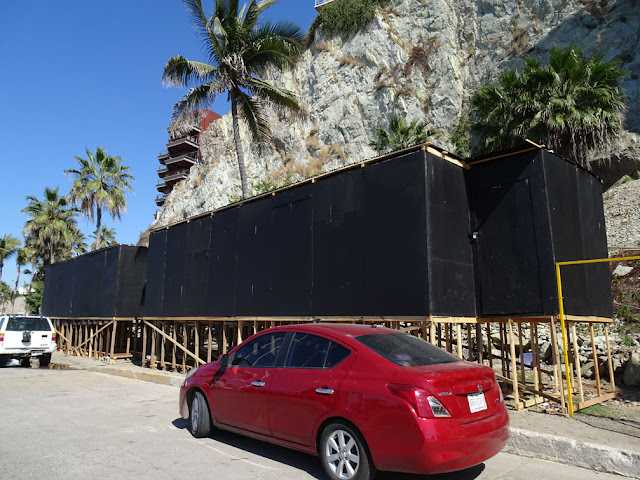The other day we took a ride up Paseo Claussen then back on Venustiano Carranza. That's a mouthfull. We actually started way before the blue line and ended way after the blue line, on the same roads but Google Maps would not cooperate with me so..
These first pictures are from Paseo Claussen. For once the fountain was working here.
Can barely see them but this house has blue whales painted on it.
The heart shaped look out point.
From just past here we made the turn on to Venustiano Carranza. There is actually a cannon between these buildings. Should have stopped and got out of car to take the picture. Original cannon? No idea.
Two big cruise ships in that day.
This is an interesting old building. No idea what it was when it was built. Not sure if it is still occupied.
Don't think that satellite dish works any more. What a tangle of wires up there.
A lot of interesting details in the construction.
Continuing on down the road. Colorful home.
This must be a pretty old section of town.
That car parked at the curb was in the parking lot on the other side of the street for years and one day it was moved to here.
The first time we came across this building it was empty and falling apart. Then one year work started on it and it was eventually repaired and painted. It is now for sale. And again it is slowly showing its lack of upkeep. It has a great history. I searched the web and finally found this from "THE MAZATLAN WEEKLY. "
Casa Herrasti
was built in 1907 as the family home of Doña Francisca Rojas de Paredes, a
direct descendant of Don Bonifacio Rojas who discovered the prosperous gold and
silver mine of El Tajo in 1655. This led to the founding of the nearby mining
town of El Rosario, Sinaloa.
It now bears the
name of Don Alejandro Herrasti, a Basque merchant who married into the family
and was the last inhabitant of the residence.
At the time of
the Mexican Revolution, the Paredes left the country and the uninhabited house
was taken over by revolutionary groups that occupied the city, as a military
barracks along with other spaces, one of which was also the Josefa Ortiz de
Domínguez school.
he house’s signature
architecture is an eclectic interpretation of classic elements artfully created
with local materials and construction techniques that extends along its three
grand street frontages that cover 23,680 square feet of multiple interior
spaces in a lot of 13 thousand 993 square feet.
We must remember that it
was one of the first house-rooms, since in those years the constructions in the
area were dedicated solely to business.
It is known as: House
Herrasti or Paredes (by its owner) and is considered an architectural
beauty of Mazatlán and more because it continues to preserve that neoclassical
style from the 19th century to the Art Deco of the early 20th century, mainly
influenced by European constructions.
It has been used as a
school by private higher-level institutions, and in 2016 it
It has been used
as a school by private higher-level institutions, and in 2016 it opened its
doors for the Delfos company, which presented a work based on the house coming
to life through human portraits.
It was the
headquarters of the University of Mazatlán and UNITESIN.
I hope some one buys it and puts some work into it soon.
























































